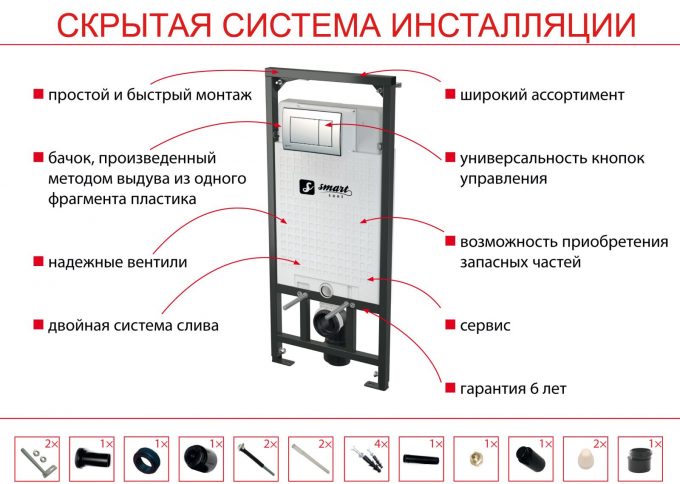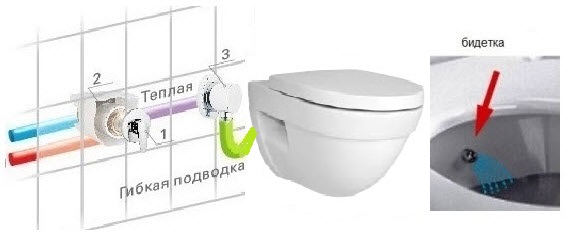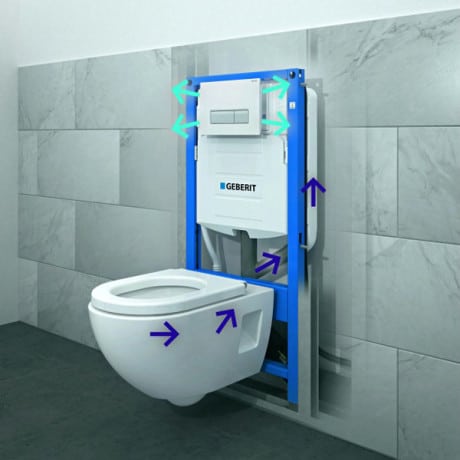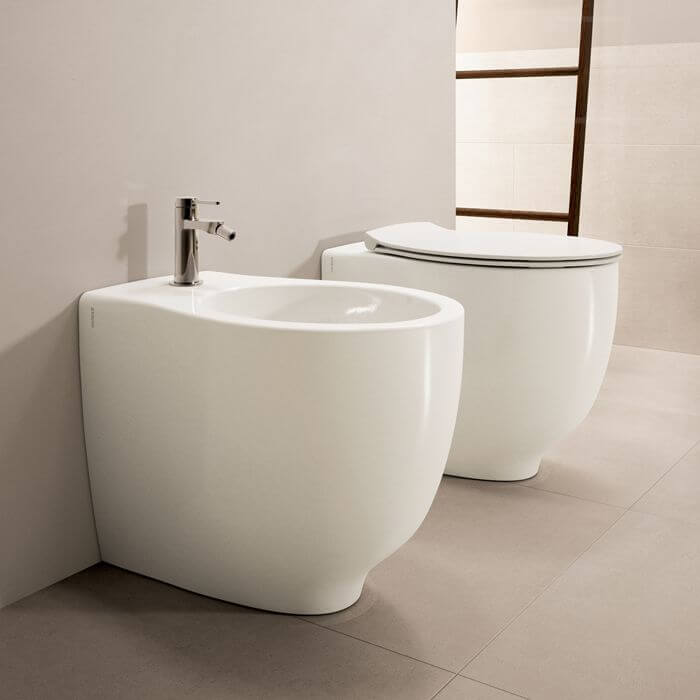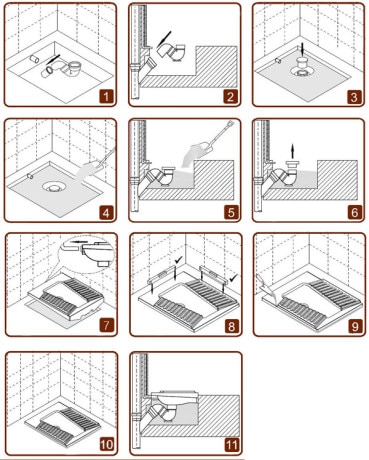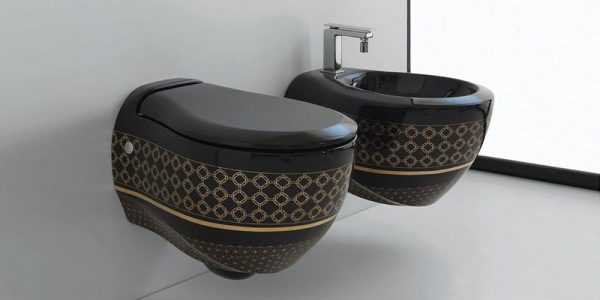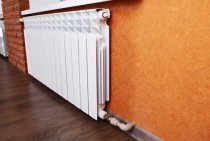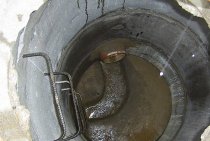Installation work - we install the structure
Thanks to the installation, a toilet bowl with a built-in cistern can be installed in any part of the room. Of course, the main factor determining the position of the product is the location of the sewer to which the device is connected. But, when contacting a competent specialist, this trouble will not become a problem.
Regardless of the position of plumbing, there are only two types of installation. The first type is classic solutions, which look like a metal frame equipped with mounts and supports. The second type of installation is a device that allows you to mount the toilet in the corner of the bathroom.
The rail installation deserves special attention. The key feature of such a product is that, in addition to the toilet bowl, it can be used to install a urinal, bidet and washbasin, while combining the entire structure into one.
Installation order
Competent installation of a toilet bowl with a built-in tank is installed according to the following rules:
- Before proceeding with the installation work, it is necessary to check the quality of the floor, walls for strength, check the good condition of communications (pipes). If the sewer pipe has become unusable over time and crumbles before our eyes, it is recommended to produce it.
- These measures will protect you from accidental collapses, malfunctions and breakdowns, which will subsequently require repair measures;
- The next step - the installation is mounted on the floor, all the studs that are included in the design of the built-in toilet are screwed in;
- After fixing the installation, it is necessary to insulate it with high quality - for these purposes, most masters choose drywall, but other materials can also be used.
- The main advantage of drywall is the ease of installation and the fact that tiles or mosaics can be easily glued onto it;
- Now, you need to take the toilet and put it on the studs. The next step is to isolate the studs themselves with special washers;
- At the final stage, only the decorative finish of the fixed structure remains, which can be made with any convenient and attractive material.
Everything, installation work is completed - the built-in toilet bowl is securely hidden in the wall and the device functions perfectly. You will be pleasantly pleased with the convenient design of such a product and the low noise level produced by the tank.
Other design features
Another unshakable advantage of such products is the efficiency of drain tanks. Standardized models of cisterns, installed on simple toilet bowls, consume about 7-9 liters of water per flush. Built-in cisterns consume about 4-5 liters per flush, which is 1.5-2 times more economical, while the quality of the flush does not suffer at all from this. If your home has water meters, such a toilet will be an excellent solution for a bathroom.
Having considered all the positive qualities and disadvantages, features of installation work and other characteristics, it becomes clear that toilet bowls with a built-in cistern are a competent and rational purchase. Such devices have a long service life and are unpretentious in terms of maintenance. If funds allow you, and you decide to make repairs in the bathroom, then purchasing a built-in toilet will be the ideal solution.
Non-built-in toilet
Quite often, ignorant users and some crazy-hands experts call floor and wall-hung toilets that integrate with built-in cisterns "built-in". Built-in tanks are of two types:
Tank mounted on a solid steel frame, the so-called "installation".First of all, the base is needed in order to fix a hanging toilet bowl on it, secondly - for the installation of pipelines, thirdly - as a frame for sewing with plasterboard or other sheet material. For the most part, manufacturers offer installations of two types: some have a height of 115-120 cm, others 75-80 cm. The second allows you to install the lining flush with the washbasin built into the countertop. Frames are adjustable in height by 4-8 cm.
A sturdy installation frame with a built-in cistern is designed to install a suspended (not built-in!) toilet bowl on it
Tank installed separately. It is insulated, equipped with the necessary fittings and fasteners, it costs significantly less than the installation kit. Designed for use with cisternless floor standing toilets.
The frameless cistern integrates with any type of cisternless toilet, including conventional floor and Turkish built-in floor
Whatever ceramic friend you decide to install in an apartment or a private house, the installation of pipelines, the connection and installation of a built-in toilet, cistern, installation, hanging or floor bowl should be done by people who are versed in plumbing. If the topic is familiar, you can do it yourself. There are no skills and necessary knowledge - in order to avoid trouble, it is better to invite specialists.
Installation without installation system
It turns out that it is possible to install a built-in toilet bowl without installation. In this case, you will install the built-in toilet directly to the wall, but the coupling for draining the liquid drain and the drain tank are in a hidden monolithic concrete base. In addition, the concrete base will perform the function of supporting the toilet from below. As practice shows, this method of fastening is in no way inferior to the installation method, and will cost you even less. To do this, you will need the following materials and tools:

And now let's look at the sequence of actions for the correct installation of the built-in toilet bowl on the base:
It is better to entrust the installation of a built-in toilet to professionals, but if you have building skills, then you can do it yourself.
A built-in toilet is the best solution for small bathrooms. This hanging option saves space. The presence on the market of a huge number of color and design solutions, allows you to choose a model exclusively to the taste of the buyer. After all, until recently, a bathroom in every house was a standardized room. Each apartment had a simple toilet. But, due to the improvement of technology, now, the toilet is something special and intimate, and everyone strives to make it as comfortable as possible.
What is good built-in toilet and what is bad
Despite the fact that “compacts”, a product of liberalism, have almost universally replaced floor devices from domestic toilets, a toilet bowl built into the floor has obvious advantages over a standard toilet seat:
- It is difficult to break it, even when heavily drunk.
- In the same drunkenness, falling in the toilet and hitting your head, you can get a fatal injury on an ordinary toilet bowl, on a Turkish one - only a slight concussion.
- Since the floor pusher does not have a seat, it is impossible to get dirty. This is a big plus if visitors are not accustomed to a civilized visit to the restroom, do not consider it necessary to raise the toilet seat and strive to crap it. In the Turkish toilet, the far side of the visitor's moon remains untouched, it does not come into contact with the snow-white porcelain.
- Cleaning a toilet with built-in toilets is easier than with conventional ones. Waste products not removed by inaccurate users can simply be washed into the bowl with a jet of water from a hose, since it is located flush with the floor.
- The medical factor is also important.An experienced proctologist will confirm that long sitting with a tablet or smartphone on a comfortable compact seat provokes a violation of the blood supply to the hemorrhoidal veins with corresponding unpleasant consequences. The squatting position, typical for users of the Turkish bowl, is not conducive to a long pastime for this activity. In addition, getting rid of toxins is more complete and, since it is necessary to maintain balance, various muscle groups of the visitor are trained. The procedure for energy consumption will completely replace a session in an expensive fitness club.
Despite the undeniable advantages and considerable popularity in public toilets in many regions, Turkish toilets built into the floor are not used in private housing. People still prefer comfort to a healthy lifestyle and want to relax, read, chat, send SMS on a comfortable toilet seat.
Scheme of installation of a floor-mounted built-in toilet bowl. The sewer outlet-ladder should be located 15-30 cm below the floor level; such a device cannot be installed in a standard apartment
Pros and cons that a built-in toilet has
A wall-mounted toilet is a popular and sought-after plumbing configuration. With the help of this design, it is possible to equip even a small room to the highest standard and make it comfortable and attractive. In addition to compactness, built-in models have a number of positive characteristics:
Ease of installation work - this feature allows you to install the model in the bathroom even with your own hands, without the involvement of professional help;
A toilet with a built-in hanging-type bidet can be adjusted in height and in the depth of planting in the wall;
For repair or preventive measures, the owner of such a device does not have to disassemble the wall - just remove the button and gain access to all nodes and connections;
Suspended structures are presented on the market in a rich variety - there are toilet bowls of various shapes and colors
Such a variety allows the user to choose a model for the design of the bathroom, without compromising the overall environment;
When installing a built-in toilet, you can pay special attention to floor tiles. It becomes possible to lay out any pattern or even a picture;
After installing a built-in toilet, you will see that cleaning is now much less time-consuming and more thorough.
The main and most serious drawback of such structures is the increased cost. Despite this, people willingly buy these products and do not regret it at all. For the sake of justice, it should be noted that built-in models are not only suspended, but also floor-standing. Fundamentally, they are no different - the only difference lies in the features of the installation work. The disadvantage of floor models with a built-in cistern is obvious - the model is adjacent to the wall closely. which causes a lot of problems when cleaning. Otherwise, the model is reliable, compact and convenient.
Choosing the Right Wall Mounted Toilet
What is attractive, the installation of a built-in toilet is carried out on walls of any type, whether it is a supporting monolithic structure, or a plasterboard partition. The main rule is to choose a quality installation system. There are several types of installation systems. For example, there is equipment that allows you to mount a toilet bowl in the corner of a room, and there are products that are a structure in the form of rails - on such fasteners you can install additional plumbing modules, for example, a sink.
But, like any design solution, this type of plumbing fixture has its drawbacks that can cause problems:
- Despite the fact that installation work does not cause problems, the main trouble is the high cost of fasteners, which scares off potential buyers;
- The client has to buy not only an expensive toilet, but also an expensive installation system;
When installing a built-in toilet in a private house, it should be noted that the pipes may not withstand the load placed on them. The same applies to walls. As a result, it is necessary to repair the pipeline and demolish the walls in order to build a stronger partition. Otherwise, there are no problems. Each model is of high quality and will serve its owner for many years without losing its attractive appearance for many years.
Pros and cons
To begin with, I would like to figure out what types of toilet bowls are:
- Floor. Mounted on the floor, fixed with screws or adhesive (cement) mortar.
- Suspended. It is mounted on the wall with the help of installation and seems to be hanging in the air. Convenient for cleanliness in the room, and also if you have a small bathroom (takes up little space).
In addition, floor-standing ones come with a drain system built into the wall, which also allows you to free up some of the free space, since the drain tank is located behind a false wall in a special niche. You can safely install a similar toilet in your home if you:
- prefer the minimalist style in the bathroom;
- it will be easier for you to clean the room, since most of the options for such toilets are suspended, which means that dirt will not accumulate under them;
- in addition to laying ceramic tiles, you can choose a specific pattern for the floor without fear that you can destroy the overall picture with a floor toilet or install;
- since all pipes and other components will be hidden behind a false wall, this guarantees you not only additional sound insulation, but also adds more aesthetics and comfort to the interior.
Oddly enough, but more and more consumers are choosing a toilet with a built-in cistern when renovating their bathroom. At the same time, you will have to take into account in advance that although the cost of installing it will not be too complicated, it will still require certain financial costs, since you will not only have to pay for the plumbing itself, but also for the installation, which will actually hold the toilet itself.
Wall hung toilet
You should also consider in advance what condition your pipes are in, because if they are not in the best condition, it is better to take care of replacing them immediately during the repair. Also, to place an installation and a hidden drain tank on the wall, you will have to spend some time in the archive in order to make sure that your wall can withstand such a load. Otherwise, consider other mounting options for the built-in toilet. This is also due to the fact that if in the future you have to repair the cistern or other fittings, then you will have to disassemble the wall again to fix the problem.
